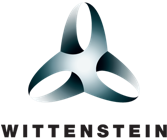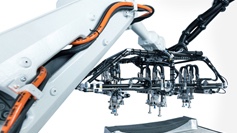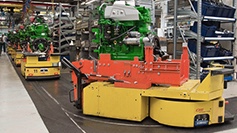New chipless principle for rack pinning
This innovative pinning method highlights very clearly how WITTENSTEIN alpha thinks outside the box – in terms of systems rather than isolated drive solutions. The ergonomic and efficient alternative to screw clamps for rack installation benefits users with a time saving of up to fifty percent. Thanks to WITTENSTEIN alpha’s new INIRA® pinning concept, the time required to install a rack is now significantly shorter.
Effective overload protection for rack systems
The foundation for pinning was laid back in 1918 with the publication of DIN 1, the very first German standard. Then, as now, this positive connection principle improved the positioning accuracy of machine components and protected them against overload. The latter is particularly crucial in applications involving racks. It stops the rack from slipping due to high loads, for instance in the event of a crash or other emergency situation. This could result in an alignment or pitch error at the interface between two racks, leading ultimately to the failure of the complete rack-and-pinion drive system. In heavily loaded axes, therefore, pinning the rack is vital in order to rule out the risk of failure or threats to availability.
Chipless pinning: added value for assembly and servicing
Chips and swarf are always undesirable during assembly work: they are difficult to control and have a destructive effect. WITTENSTEIN alpha’s new chipless pinning principle successfully amends a proven method that was first established in the market several decades ago; it was developed in response to customer demands for quick and easy assembly. Chipless pinning offers numerous advantages for machine builders: instead of drilling and reaming the rack and the machine bed together in a time consuming process and then driving in the pin, this innovative, two-piece assembly solution from WITTENSTEIN alpha facilitates a secure and completely chipless connection! The holes which are required in the bed can be machined to fit exactly when the components are manufactured – in a single setting with the fixing holes. The two-piece mounting kit is comprised of a special pin and sleeve, which are fitted together using just a hammer and an Allen key. The time saving as a result of this chipless assembly process is quite substantial: each rack can be securely fixed with a positive connection in less than 60 seconds – compared to 35 or 40 minutes with conventional pinning. Easy dismantling and reusability mean the rack can be exchanged rapidly in case of repairs or retrofits.
Commitment to “efficiency engineering”
The new INIRA® rack pinning principle is a further illustration of how WITTENSTEIN alpha defines “efficiency engineering”. The focus is not confined to innovative, high performance products; optimized machine concepts, control technology, software, tools and processes are equally in the spotlight. “Efficiency engineering” combines all effectiveness and efficiency aspects of WITTENSTEIN alpha products, systems and solutions, which are based on efficient engineering services and efficient production processes.
Photos:
1. The assembly pin is inserted into the mounted rack and driven into the pre-drilled hole in the machine bed.
2. The assembly sleeve and pin are turned in opposite directions, so that the sleeve engages in the hole. The sleeve is then pressed in half-way by hand.
3. Finally, the assembly sleeve is driven in flush with a hammer.
4. Three steps to chipless rack pinning.


